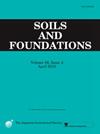煅烧废磷渣对分散土分散性和力学性能的改良作用
IF 3.3
2区 工程技术
Q2 ENGINEERING, GEOLOGICAL
引用次数: 0
摘要
分散性土壤是工程项目中常见的问题土壤,具有导致严重工程故障的潜在风险。本文选用煅烧过的废磷渣(CPS)来增强土体的力学性能,降低土体的分散性。制备了 CPS 含量为 1 % 至 10 % 的分散性土壤样本,并将其固化 0 至 28 天。分散性鉴定测试用于评估土壤样品的分散性。还测定了土壤的抗压和抗拉强度、电导率和 pH 值。使用 SEM/EDS、TG/DTG 和 XRD 分析法对微观结构和矿物成分进行了分析。为了验证 CPS 在改良土壤方面的效果,我们选择了天然分散土壤。实验表明,CPS 可抑制土壤的分散性,并将其转化为非分散性土壤。随着 CPS 含量和固化时间的增加,抗压和抗拉强度都有显著提高。随着 CPS 混合含量从 1% 增加到 10%,固化 28 天的土壤样本的抗拉强度增加了约 76%,抗压强度增加了约 61%。结果表明,CPS 可提高强度并改变土壤的分散性,其最佳混合含量为 5%。此外,在分散性土壤中使用 CPS 还能解决磷矿渣的处置问题,可谓一举两得。本文章由计算机程序翻译,如有差异,请以英文原文为准。
Modifying behavior of calcined waste phosphorus slag on the dispersivity and mechanical properties of dispersive soil
Dispersive soil is a common problem soil in engineering projects, which has the potential risk of causing serious engineering failures. In this paper, calcined waste phosphorus slag (CPS) was chosen to enhance the mechanical properties and reduce soil dispersivity. Dispersive soil samples with 1 % to 10 % CPS content were prepared and cured for 0 to 28 days. The dispersivity identification test was used to assess soil sample dispersivity. The compressive and tensile strength, conductivity, and pH were determined for the soil. Microstructural and mineral composition were analyzed using SEM/EDS, TG/DTG, and XRD analysis. The natural dispersive soil was selected to verify the effect of CPS in improving soil. Experiments show that the CPS inhibits soil dispersivity and converts it into non-dispersive soil. Both compressive and tensile strength increases significantly with the increase in the content of CPS and curing time. The tensile strength of the soil samples cured for 28 days increased by about 76 % and the compressive strength by about 61 % as the mixed content of CPS was increased from 1 % to 10 %. Results show that CPS can improve the strength and modify the dispersivity of soil, its optimal mixing content is 5 %. In addition, using CPS in dispersive soil could also solve the disposal problem of phosphate slag, which is a win-to-win solution.
求助全文
通过发布文献求助,成功后即可免费获取论文全文。
去求助
来源期刊

Soils and Foundations
工程技术-地球科学综合
CiteScore
6.40
自引率
8.10%
发文量
99
审稿时长
5 months
期刊介绍:
Soils and Foundations is one of the leading journals in the field of soil mechanics and geotechnical engineering. It is the official journal of the Japanese Geotechnical Society (JGS)., The journal publishes a variety of original research paper, technical reports, technical notes, as well as the state-of-the-art reports upon invitation by the Editor, in the fields of soil and rock mechanics, geotechnical engineering, and environmental geotechnics. Since the publication of Volume 1, No.1 issue in June 1960, Soils and Foundations will celebrate the 60th anniversary in the year of 2020.
Soils and Foundations welcomes theoretical as well as practical work associated with the aforementioned field(s). Case studies that describe the original and interdisciplinary work applicable to geotechnical engineering are particularly encouraged. Discussions to each of the published articles are also welcomed in order to provide an avenue in which opinions of peers may be fed back or exchanged. In providing latest expertise on a specific topic, one issue out of six per year on average was allocated to include selected papers from the International Symposia which were held in Japan as well as overseas.
 求助内容:
求助内容: 应助结果提醒方式:
应助结果提醒方式:


